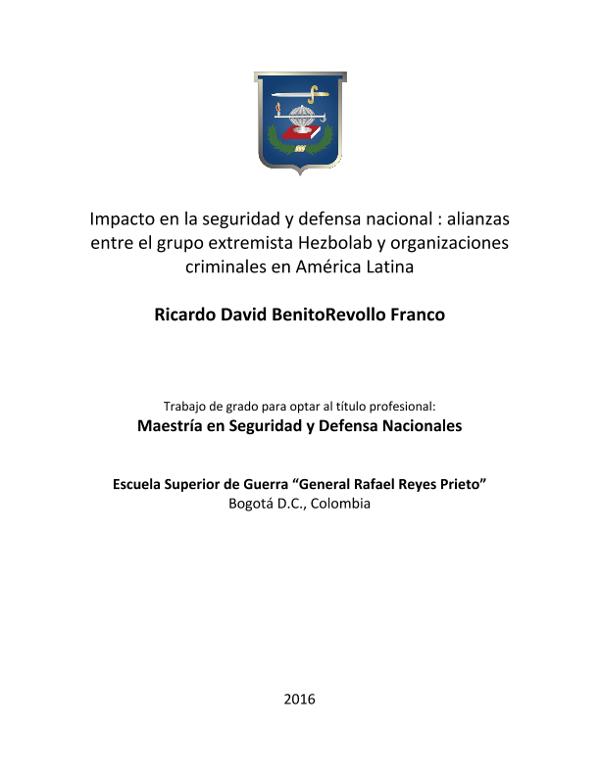| dc.rights.license | http://creativecommons.org/licenses/by-nc-nd/4.0/ | |
| dc.contributor.advisor | Ramírez Pedraza, Yesid Eduardo | |
| dc.contributor.advisor | Barrera Herrera, Oscar Felipe | |
| dc.contributor.author | Benitorevollo Franco, Ricardo David | |
| dc.coverage.spatial | Bogotá | |
| dc.date.accessioned | 2022-12-26T14:48:37Z | |
| dc.date.available | 2022-12-26T14:48:37Z | |
| dc.date.issued | 2016 | |
| dc.identifier.uri | https://hdl.handle.net/20.500.14205/4612 | |
| dc.description.abstract | Dentro del contexto de la evolución de la forma de hacer la guerra irregular, guerra irrestricta o guerra de cuarta generación, se presenta un concepto nuevo llamado “convergencia”, definida por el Almirante James G. Stavridis, USN, en el libro “Convergence”, como una asociación hibrida de organizaciones ilícitas transnacionales, redes de narcotráfico y terrorismo que se origina de la necesidad de financiamiento de grupos armados ilegales para llevar a cabo el cumplimiento de sus objetivos bélicos e ideológicos. El objetivo de este artículo de reflexión es analizar la existencia de alianzas entre grupos de naturaleza terrorista de medio oriente como Hezbollah con organizaciones armadas ilegales y terroristas en América Latina como las Fuerzas Armadas Revolucionarias de Colombia (en adelante: FARC). Así mismo, este estudio permitirá adquirir bases cognitivas del fenómeno de la “convergencia” en la región para poder entender y actuar ante esta amenaza y poder implementar un tipo de estrategia integral que incluya la cooperación de organismos en la recopilación y análisis de datos de inteligencia y la formulación de políticas en seguridad y defensa a nivel regional. Douglas Farah plantea en su obra “El crimen Transnacional, Terrorismo y Estados criminalizados en América Latina”, la existencia de una posible alianza entre Irán, principal patrocinador de Hezbollah y Venezuela dirigida entonces por Hugo Chávez. Tales alianzas, se caracterizaron por el apoyo financiero y de material bélico a la organización marxista-leninista FARC denominada como Organización Terrorista por Estados Unidos y la Unión Europea en el 2002. Las FARC son responsables de la producción de más del 60% de la cocaína en el mundo, y en los últimos años ha estrechado sus vínculos con los carteles mexicanos de droga.(tomado del texto) | es_ES |
| dc.description.abstract | Within the context of the evolution of the way of making irregular warfare, unrestricted war or fourth generation warfare, a new concept called "convergence" defined by Admiral James G. Stavridis, USN, in the book "convergence" is presented as a hybrid association of transnational illegal organizations, networks of drug trafficking and terrorism that originates from the need to finance illegal armed groups to carry out the fulfillment of their military and ideological objectives.The aim of this article is to analyze the existence reflection of alliances between terrorist groups nature of the Middle East as Hezbollah with illegal armed groups and terrorists in Latin America and the FARC. Also this study will acquire knowledge bases of the phenomenon of "convergence" in the region to understand and act on this threat and to implement a kind of comprehensive strategy that includes cooperation agencies in the collection and analysis of intelligence data and policy on security and defense at the regional level.As says Douglas Farah in his work "The Transnational Crime, Terrorism and the United criminalized in Latin America", is known of a possible alliance that existed or exists between Iran, a radical Islamist thought and main sponsor of Hezbollah and the government the time of President of Venezuela Hugo Chavez. Such alliances were characterized by financial support and materiel to the Marxist-Leninist organization "Revolutionary Armed Forces of Colombia" (FARC) designated as a terrorist organization by the United States and the European Union, which produces more than 60% of the world's cocaine and is increasingly strengthening its ties with Mexican drug cartels (tomado del texto) | es_ES |
| dc.format.medium | Recurso electrónico | |
| dc.format.mimetype | application/pdf | |
| dc.language.iso | spa | |
| dc.rights.uri | Attribution-NonCommercial-NoDerivatives 4.0 International (CC BY-NC-ND 4.0) | |
| dc.title | Impacto en la seguridad y defensa nacional : alianzas entre el grupo extremista Hezbolab y organizaciones criminales en América Latina | |
| datacite.rights | http://purl.org/coar/access_right/c_abf2 | |
| oaire.resourcetype | http://purl.org/coar/resource_type/c_bdcc | |
| oaire.version | http://purl.org/coar/version/c_970fb48d4fbd8a85 | |
| thesis.degree.grantor | Escuela Superior de Guerra General Rafael Reyes Prieto | |
| thesis.degree.level | Tesis de Maestría | |
| thesis.degree.name | Maestría en Seguridad y Defensa Nacionales | |
| dc.description.notes | 52 páginas | |
| dc.description.notes | Incluye bibliografía en página 46-51 | |
| dc.identifier.instname | Escuela Superior de Guerra General Rafael Reyes Prieto | |
| dc.identifier.reponame | Repositorio ESDEG | |
| dc.publisher.program | Maestría en Seguridad y Defensa Nacionales | |
| dc.rights.accessrights | info:eu-repo/semantics/openAccess | |
| dc.subject.keywords | Crimen Transnacional - Influencia - América Latina | |
| dc.subject.keywords | Seguridad Nacional - América Latina | |
| dc.subject.keywords | Defensa Nacional - América Latina | |
| dc.subject.keywords | Crimen Organizado - Influencia - América Latina | |
| dc.subject.keywords | Espacios Vacios - América Latina | |
| dc.subject.keywords | Organizaciones Del Crimen Transnacional - Influencia - América Latina | |
| dc.subject.keywords | Contrabando - América Latina | |
| dc.subject.keywords | Maestría En Seguridad Y Defensa Nacional - Tesis Y Disertaciones Académicas | |
| dc.subject.keywords | Hezbollah (Grupo Terrorista) - Influencia | |
| dc.type.driver | info:eu-repo/semantics/masterThesis | |
| dc.type.hasversion | info:eu-repo/semantics/acceptedVersion | |
| dc.type.redcol | http://purl.org/redcol/resource_type/TM | |
| dc.type.spa | Trabajo de grado de maestría | |


